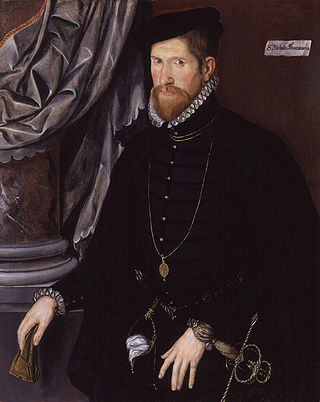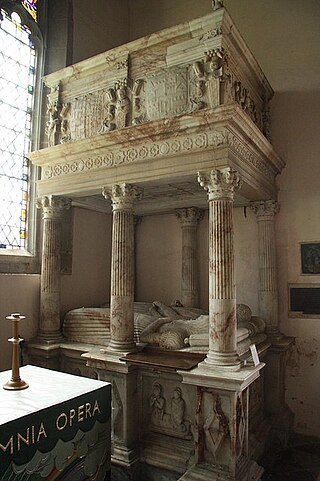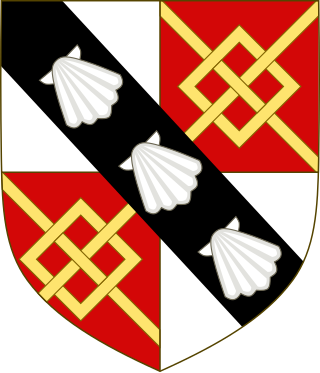Related Research Articles

Sir Thomas Tresham was a prominent recusant Catholic landowner in Elizabethan Northamptonshire. He died two years after the accession of James VI and I.
Sir Thomas Tresham was a British politician, soldier and administrator. He was the son of Sir William Tresham and his wife Isabel de Vaux, daughter of Sir William Vaux of Harrowden. Thomas's early advancement was due to his father's influence. In 1443 he and his father were appointed as stewards to the Duchy of Lancaster's estates in Northamptonshire, Buckinghamshire, Bedfordshire and Huntingdonshire, and by 1446 Thomas was serving as an esquire for Henry VI, being made an usher of the king's chamber in 1455. He was appointed a Justice of the Peace for Huntingdonshire in 1446, a position he held until 1459, and was returned to Parliament for Buckinghamshire in 1447 and Huntingdonshire in 1449. Despite the Tresham family's close links with the royal court they were also on good terms with Richard Plantagenet, 3rd Duke of York, and when he returned from Ireland in 1450 Tresham and his father went to greet him. Shortly after leaving home on 23 September they were attacked by a group of men involved in a property dispute with his father; William Tresham was killed, and Thomas was injured.

Sir Nicholas Throckmorton was an English diplomat and politician, who was an ambassador to France and later Scotland, and played a key role in the relationship between Elizabeth I of England and Mary, Queen of Scots.

Sir Edward Montagu of Boughton, Hanging Houghton and Hemington in Northamptonshire was an English lawyer and judge in the time of Henry VIII and Edward VI. He was Chief Justice of the King's Bench from 1539 to 1545 and Chief Justice of the Common Pleas from 1545 to 1553.

William Parr, Marquess of Northampton, Earl of Essex, 1st Baron Parr, 1st Baron Hart, was the only brother of Queen Catherine Parr, the sixth and final wife of King Henry VIII. He was a "sincere, plain, direct man, not crafty nor involved", whose "delight was music and poetry and his exercise war" who co-authored a treatise on hare coursing. He was in favour with Henry VIII and his son Edward VI, under whom he was the leader of the Protestant party, but having supported the desire of the latter to be succeeded by the Protestant Lady Jane Grey, was attainted by Edward's Catholic half-sister, Queen Mary I. He was restored by her Protestant half-sister, Queen Elizabeth I. He married thrice but died without issue.
William Parr, 1st Baron Parr of Horton was the son of Sir William Parr and his second wife, the Hon. Elizabeth Fitzhugh, later Lady Vaux of Harrowden.

Sir John Throckmorton was a lawyer and member of the English Parliament during the reign of Queen Mary I. He was also a witness to Queen Mary's will.
Sir James Harington of Exton was a 16th-century English public servant who fulfilled a number of legal, legislative and law enforcement duties and was knighted in 1565.
Sir Edward Saunders was an English judge and Chief Justice of the Queen's Bench.
Sir Robert Knollys was an English courtier in the service and favour of Henry VII and Henry VIII.

Sir Adrian Fortescue was a courtier at the court of King Henry VIII of England and member of the Third Order of Saint Dominic who was executed in 1539 and later beatified as a Roman Catholic martyr.
Anne Bourchier was the suo jure7th Baroness Bourchier, suo jureLady Lovayne, and Baroness Parr of Kendal. She was the first wife of William Parr, 1st Marquess of Northampton, Earl of Essex, and the sister-in-law of Catherine Parr, the sixth wife of Henry VIII of England.

William Vaux, 3rd Baron Vaux of Harrowden was an English peer. He was noted for his Roman Catholic faith and support of Catholic missionary activity.
Sir Nicholas Hare of Bruisyard, Suffolk was Speaker of the House of Commons of England between 1539 and 1540.

Sir Robert Throckmorton, KG, of Coughton Court in Warwickshire, was a Member of Parliament and a distinguished English courtier. His public career was impeded by remaining a Roman Catholic.
Kenelm Digby of Stoke Dry, Rutland was an English politician. He was first elected MP for Stamford in 1539 and Sheriff of Rutland in 1541.

Rushton Hall in Rushton, Northamptonshire, England, was the ancestral home of the Tresham family from 1438, when William Tresham, a veteran of the Battle of Agincourt and Chancellor of the Duchy of Lancaster bought the estate. In the 20th century the house became a private school and it has now been converted to a luxury hotel. The estate is about 227 acres (92 ha) of which 30 acres (12 ha) are formal gardens. The River Ise flows from west to east south of the Hall.

Sir John Spencer was an English nobleman, politician, knight, sheriff, landowner, and Member of Parliament. He was an early member of the Spencer family.
Sir William FitzWilliam, of Windsor, Berkshire, was an Irish courtier and Member of Parliament in England. He was Chief Gentleman of the Privy Chamber to Edward VI of England; Deputy Chancellor of Ireland; Lieutenant of Windsor Castle; Keeper of Windsor Great Park and Lord Lieutenant of Berkshire.
Sir Thomas Curtis was an English pewterer and politician who was elected Lord Mayor of London in 1556. He was knighted in 1557.
References
- 1 2 3 4 5 Herbermann, Charles, ed. (1913). . Catholic Encyclopedia . New York: Robert Appleton Company.
- ↑ Burke, John. A genealogical and heraldic history of the extinct and dormant baronetcies of England, Ireland, and Scotland, pg. 532. Google eBook
- ↑ Some sources state that it was Anne Parr who married Tresham. However, according to Douglas Richardson, Anne was married to Sir John Digby.
- ↑ The History of Parliament: the House of Commons 1509–1558, ed. S.T. Bindoff, 1982. TRESHAM, Sir Thomas (by 1500–59), of Rushton, Northants. History of Parliament Online. Accessed 4 December 2022.
- History of Parliament TRESHAM, Sir Thomas (by 1500–59) of Rushton, Nortants
- Lee, Sidney, ed. (1899). . Dictionary of National Biography . Vol. 57. London: Smith, Elder & Co.
 This article incorporates text from a publication now in the public domain : Herbermann, Charles, ed. (1913). "Sir Thomas Tresham". Catholic Encyclopedia . New York: Robert Appleton Company.
This article incorporates text from a publication now in the public domain : Herbermann, Charles, ed. (1913). "Sir Thomas Tresham". Catholic Encyclopedia . New York: Robert Appleton Company.